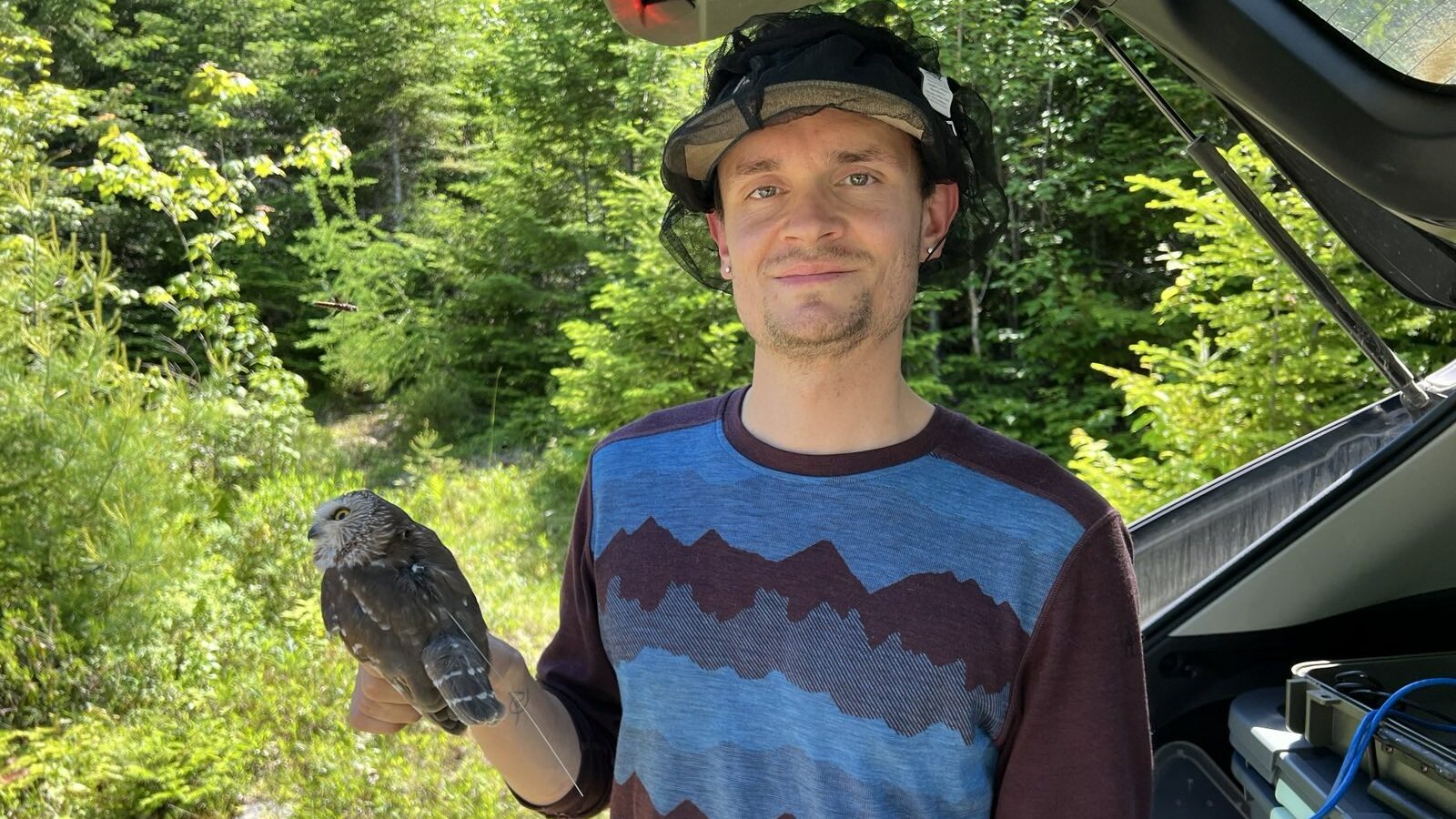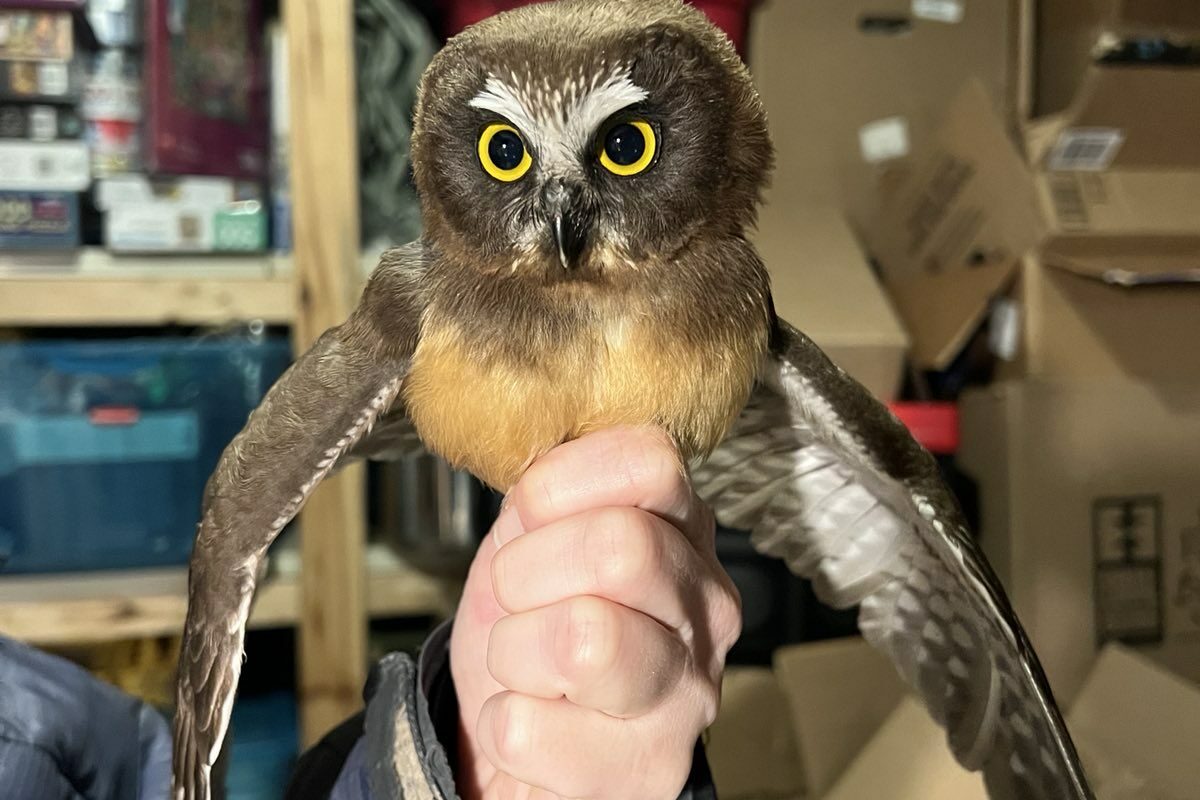By: Aaron Coolman, Motus Technical Coordinator and Avian Ecologist

This past summer, I embarked on a remarkable journey to unravel the mysteries of one of North America’s most elusive bird species—the Northern Saw-whet Owl. My travels took me from the dense boreal forests of Nova Scotia, Canada, to the wild shores of Lake Superior, Michigan. In partnership with renowned researchers, I set out to capture and tag these tiny owls with cutting-edge Motus transmitters to unlock new insights into this secretive bird’s migration and breeding behaviors.
Armed with Motus technology, which allows us to track wildlife movements in unprecedented detail, we hope to shed light on where Northern Saw-whet Owls travel after breeding, how they navigate vast landscapes, and the hidden corridors they follow as they move across North America. What we discover may change how we understand these charismatic birds—and it’s all part of WCT’s commitment to advancing conservation science.
My first stop was Nova Scotia, where I teamed up with Randy Lauff in the town of Antigonish. Just outside of town lies Archibald Lake, a freshwater lake recently designated a Provincial Wilderness Area. Spanning 684 hectares, this protected land is home to old-growth forests, wetlands, and critical habitat for moose, Brook Trout, Atlantic Salmon, and a diversity of breeding songbirds, including the Canada Warbler and Evening Grosbeak. Among these thriving species is the Northern Saw-whet Owl, which nests in the dense stands of Black Spruce, Balsam Fir, and Eastern Hemlock that blanket the region.
For more than 20 years, Randy has maintained a network of nest boxes for saw-whets in eastern Nova Scotia. When I heard that he was recording his most successful breeding season yet, I asked if he was interested in deploying Motus tags on the adult females tending their nests. He enthusiastically agreed, and I was on my way to Canada within days.
The process of capturing and tagging the owls was quick. The female owls were found sitting faithfully inside their nest boxes, incubating their eggs. After carefully weighing, measuring, and banding each owl, I attached the Motus tags, which are lightweight and harmless to the birds. Within 30 minutes, each owl was released back into her nest box, resuming her incubation duties. These were the first Motus-tagged Northern Saw-whet Owls in eastern North America known to be actively breeding—a milestone for our research!

Only a few days after returning from Nova Scotia, I was off again—this time to Lake Superior, Michigan. Here, owl banders Chris Neri and Nova Mackentley have uncovered a previously unknown breeding population of Northern Saw-whet Owls. Since the mid-2010s, they have banded over 200 juvenile saw-whets every summer, from July through mid-August. This discovery is especially significant because saw-whets were not previously known to breed in such numbers in the lower 48 states, particularly at this low elevation. Most breeding activity in the U.S. occurs in high-altitude regions like the Rocky Mountains or the cloud forests of New Mexico and Arizona.
With the help of Chris and Nova, we successfully deployed 22 Motus tags on adult and juvenile owls. If you take a close look at juvenile saw-whets, you’ll notice that their plumage is quite different from the adults. Juveniles sport dark chocolate feathers on their heads and backs, while their bodies are rich golden-brown, resembling freshly baked cookies. Remarkably, within 12–16 weeks, they’ll molt these feathers and take on the appearance of an adult owl—a stunning transformation that’s like a tiny owl magic trick!
By tagging both adult and juvenile saw-whets, we aim to answer important questions about their post-breeding behavior. Where do they go after the breeding season? When do they leave their nesting areas? Will they return to the same locations next year? And where will they spend the winter months? The Motus Wildlife Tracking System offers us an unprecedented opportunity to gather this data, and WCT is proud to be leading the charge in this vital area of migration science. Be sure to follow along by keeping up with our owls at Project #753 on motus.org!
While my research has taken me deep into northern forests, you don’t have to travel far to encounter the magic of the Northern Saw-whet Owl. In fact, these migratory owls visit our very own backyards in Willistown! Every winter, saw-whets find shelter in the dense hedgerows, riparian corridors, forest pockets, and native shrub gardens scattered throughout the region. WCT has been actively involved in monitoring saw-whet owl migration since 2012, banding these charming little owls at Rushton Farm as part of Project Owlnet. This research forms the basis of my Master’s of Science thesis at the University of Delaware, with significant support from Project Owlnet, who generously provided funding for the Motus tags used on these trips. With your help and support, we are uncovering the hidden lives of Northern Saw-whet Owls- illuminating previously unknown parts of their lives.
This research is being conducted as the basis for my Master’s of Science thesis, where I am enrolled at the University of Delaware. Significant support comes from Project Owlnet, who has gracefully provided me with funding to purchase research materials, such as the Motus tags used on this trip.

